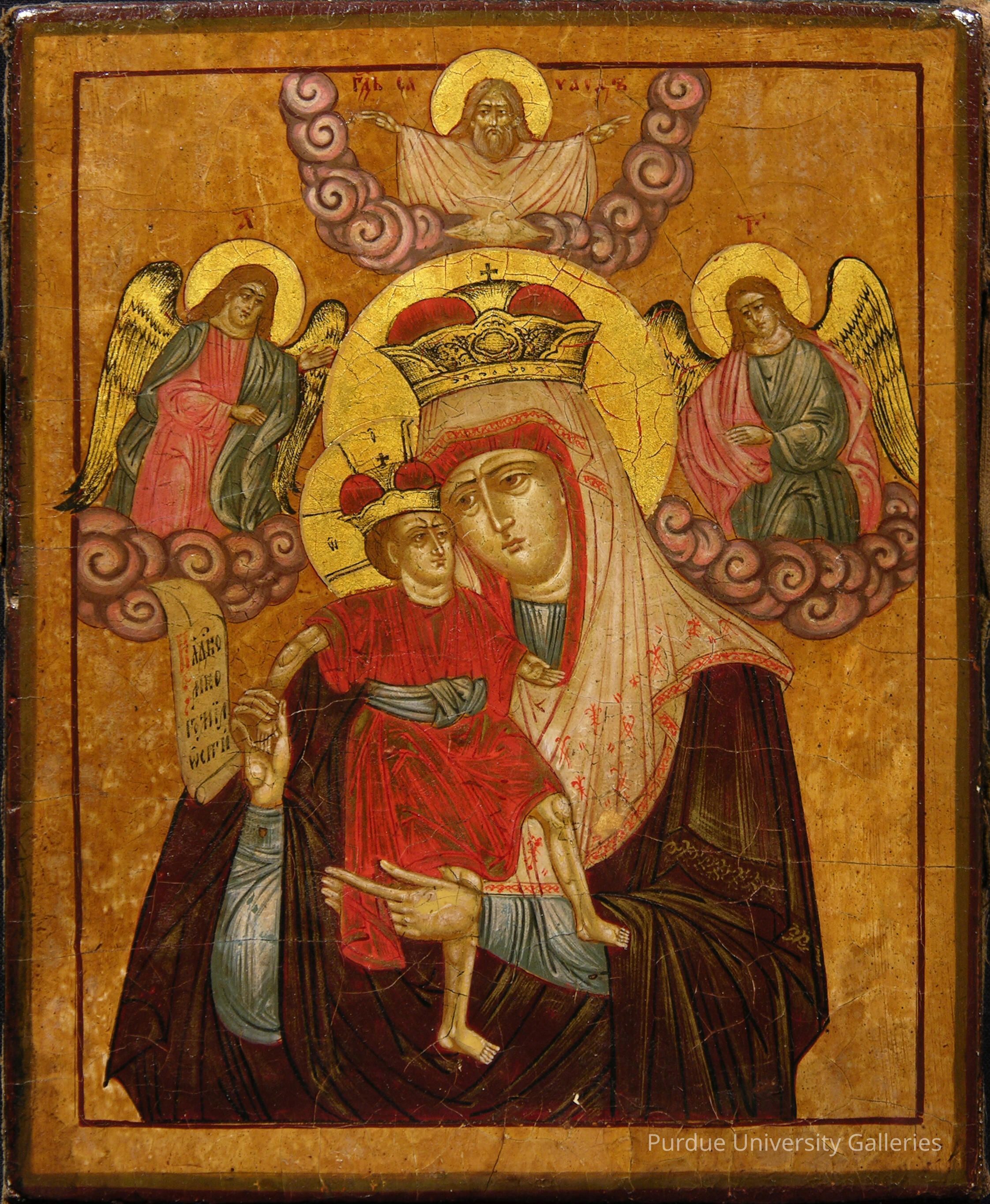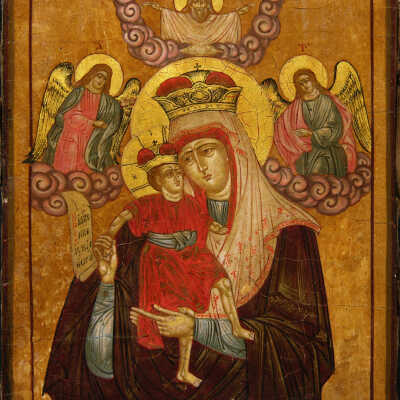Mother of God of Tenderness and Other Figures, The
Name/Title
Mother of God of Tenderness and Other Figures, TheEntry/Object ID
2005.02.018Description
Tempera on curved wooden panel backed in yellow velvet. The panel is bordered in brown, live green, and mustard yellow. The Lord Sabaoth is in the upper middle clothed in white robes with both arms outstretched in blessing. A white dove, symbol of the Holy Spirit, appears just below him within the stylized, curling clouds in shades ranging from pale pink to brown. The Archangels Gabriel and Michael, both with gilded wings, flank the central figure of the Mother of God holding the Christ child in her arms. Both archangels are shown emerging from stylized clouds similar to those below the Lord Sabaoth. A scroll descends from the clouds at left. Mary wears a red and gold openwork crown over a white maphorion with red floral ornament along the edges. She touches her cheek with the Christ child who wears a matching crown and red robes with a blue sash. The child is held on the right side of his mother, who wears a blue dress under maroon robes. Accompanied by detached silver riza backed on blue cardstock. The borders are stamped and chased with interlace ornament with floral motifs and frame the central figures within a shaped arch. Halos, parts of robes and the scroll are all gilded. The riza departs from the icon’s design in several places, including inscriptions identifying the iconographical subject. The designer of the riza has given her a six-pointed coronet while retaining the openwork imperial-style crown for the Christ child. Her robes have been further embellished in imitation of a woven brocade with fringe, while the floral ornament seen on her maphorion on the icon has not been reproduced.Type of Painting
PanelArtwork Details
Medium
Tempera, Wood panel, Gilding, SilverCollection
Betsy Scheuring Icon CollectionAcquisition
Accession
2005.02Source or Donor
Betsy ScheuringAcquisition Method
GiftCredit Line
Gift of Betsy ScheuringMade/Created
Time Period
19th Century, 20th CenturyPlace
* Untyped Place
BelarusInscription/Signature/Marks
Type
Makers MarkLocation
Bottom edge of the riza under the floral borderTranscription
A.M/1865, ИВ, 84, St. Petersburg city hallmarkLanguage
CyrillicTranslation
A.M/1865 (mark of St. Petersburg District Assayer Aleksandr Nikolaevich Mitin, I.V. (unidentified silversmith), 84 (silver purity of 84 zolotniki)Notes
This St. Petersburg hallmark (crossed anchors with scepter in the middle) used 1818-1865- Dr. KK 2023Type
InscriptionLocation
At the top of the painting, on either side of the figure of the Lord Sabaoth (also called the Lord of Hosts or God the Father)Transcription
Left: Г[ОСПО]ДЬ СА (transl. Gospod'; Savaof) Right: ВАОФЪLanguage
Church SlavonicTranslation
Left: Gospod'; Savaof Right: VAOFNotes
Translation by Dr. KK 2023Type
InscriptionLocation
Above the head of the Archangel Mikhail (Michael) at left and that of the Archangel Gavriil (Gabriel) at right in the paintingTranscription
Cyrillic letter А (A) above the head of the Archangel Mikhail (Michael) at left Cyrillic letter Г (G) above the head of the Archangel Gavriil (Gabriel) at rightLanguage
Church SlavonicTranslation
The two are an abbreviation of “Angel of the Lord” (Ангел Господень, transl. Angel Gospoden';).Notes
Translation by Dr. KK 2023Type
InscriptionLocation
In the infant’s cruciform halo in the paintingTranscription
Traces of the Greek letters ὁ ὤнLanguage
GreekTranslation
They are usually translated as “He Who Is” or “I Am Who I Am,” the name of God used in Exodus 3:14.Notes
Translations by Dr. KK 2023Type
InscriptionLocation
On either side of the figure of the Lord Sabaoth on the rizaTranscription
Left: Cyrillic letters ПРЕ (PRE) with titlo, an abbreviation of Пресвятая , and БЦА (BTsA), an abbreviation of Богородица Right: Cyrillic ДОСТОЙ[НО] ЕСТЬLanguage
Cyrillic alphabet, RussianTranslation
Left: Presviataia, Holy and Bogoroditsa, Mother of God Right: Dostoino est';, It is Meet with a titlo above the end of the first wordNotes
Titlo definition from the Slavic Cataloging Manual: “Printed resources in Church Slavic often follow old manuscript practices and abbreviate certain words by omitting letters. Omission is designated by a special symbol, placed directly above the abbreviation, and called “titlo” (brevigraph) that can look either like a tilde ( ~ ) or an upside down bracket.” Updates and translations done by Dr. KK 2023Type
InscriptionLocation
To the right of the Mother of God’s shoulderTranscription
Church Slavic letter МИЛУЮЩАЯLanguage
Church SlavonicTranslation
Miluiushchaia, The MercifulNotes
Translations by Dr. KK 2023Lexicon
Nomenclature 4.0
Nomenclature Secondary Object Term
IconNomenclature Primary Object Term
Symbol, ReligiousNomenclature Sub-Class
Religious ObjectsNomenclature Class
Ceremonial ObjectsNomenclature Category
Category 08: Communication ObjectsDimensions
Height
7 inWidth
5-11/16 inDepth
1 inExhibitions
Spirit Made Tangible: The Scheuring Icon Collection (2006)
Surveying the Sacred: Analysis of the Scheuring Collection of Eastern Orthodox Icons (2025)

